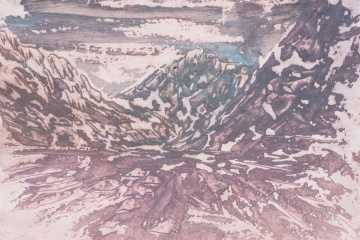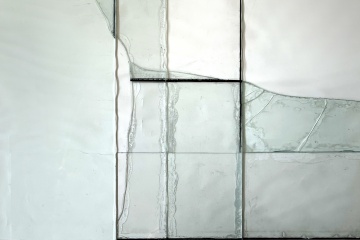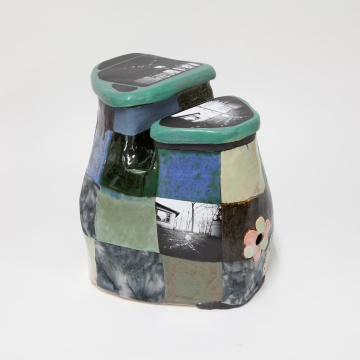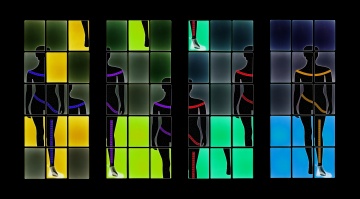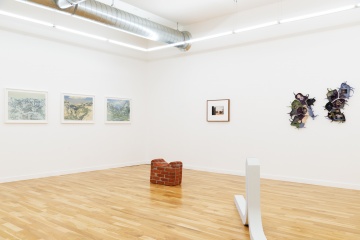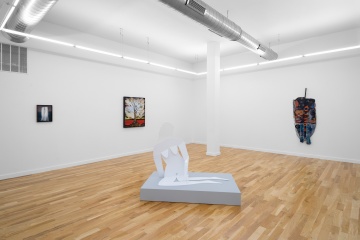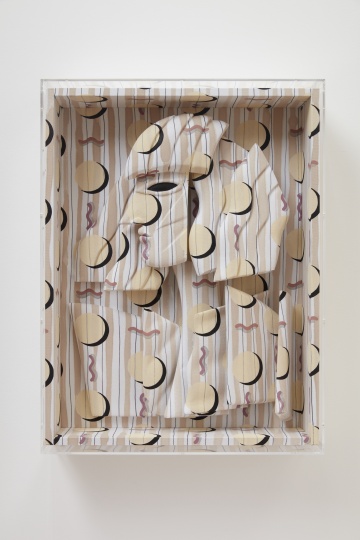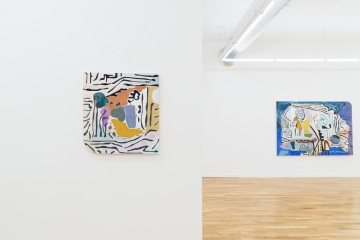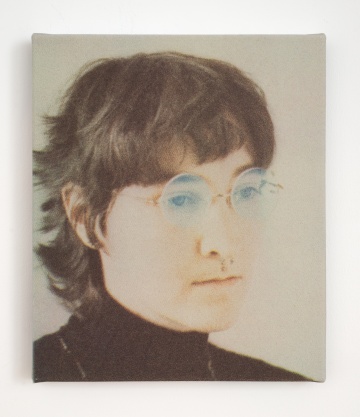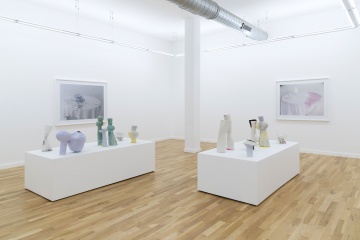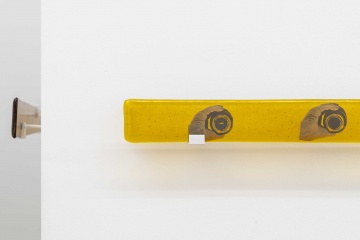DOCUMENT
1709 West Chicago Avenue
Chicago, IL 60622
312 535 4555
Chicago, IL 60622
312 535 4555
DOCUMENT is a commercial gallery located in Chicago and Lisbon that specializes in contemporary photography, sculpture, and media based art. The gallery has organized more than 70 solo exhibitions since its opening in 2012 and actively promotes the work of emerging and established national and international artists.
In our Chicago location, we conjointly operate as a photographic printmaking studio facilitating the production of works by artists from Chicago and around the world.
DOCUMENT is a member of the Art Dealers Association of America, the New Art Dealers Alliance and the International Galleries Alliance.
Artists Represented:
Elizabeth Atterbury
Geraldo de Barros
Kiah Celeste
Julien Creuzet
Anneke Eussen
Victoria Fu
Gordon Hall
Sterling Lawrence
Laura Letinsky
Christopher Meerdo
Erin Jane Nelson
John Opera
Sara Greenberger Rafferty
Paul Mpagi Sepuya
Tromarama
Andrew Norman Wilson


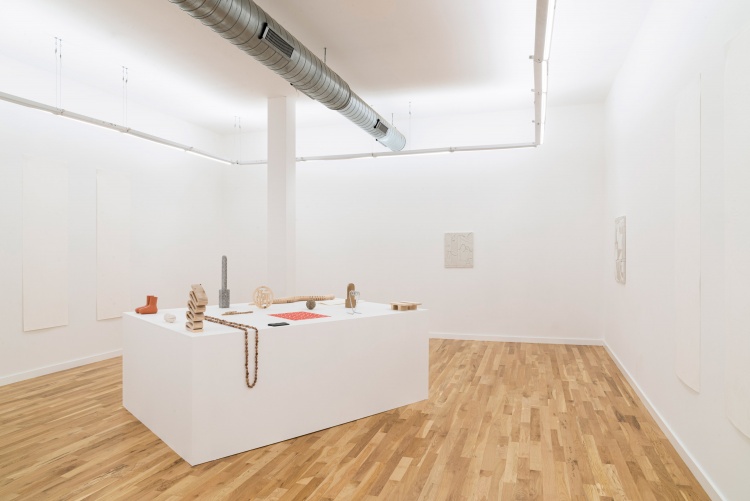
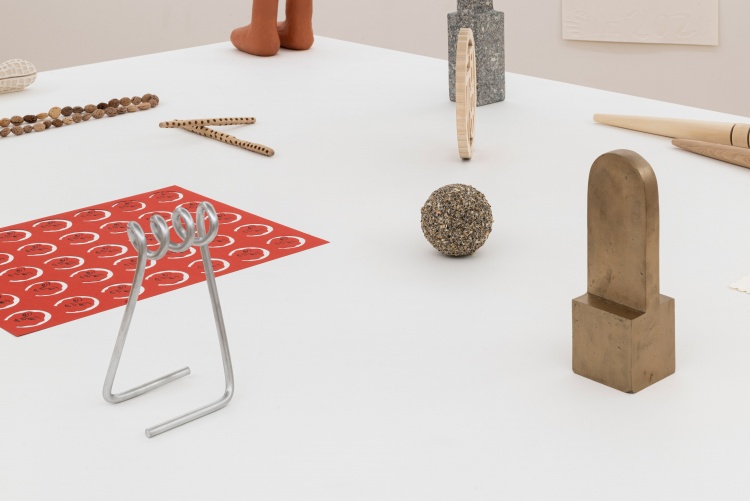
Paul Mpagi Sepuya: Stage
Elizabeth Atterbury: Letters and Souvenirs
Elizabeth Atterbury: Letters and Souvenirs
Pedro Vaz
Beginner's Mind
February 28, 2025 - April 12, 2025
DOCUMENT Chicago is pleased to present Beginner's Mind, a solo exhibition of 108 paintings on Indian cotton paper, a video, and two maps by Portuguese artist Pedro Vaz (b. Maputo, Mozambique, 1977).
Pedro Vaz’s exhibition Beginner’s Mind began long before he conceived it. One could say its origins trace back thirty-five years, to 1991, when artist Rui Calçada Bastos, then twenty years old, set out on a trek through the Indian Himalayas—an experience that later gave rise to the photographic series Paisagem para Desaparecidos II (“Landscape for the Disappeared II”, 2018). But its roots stretch even deeper, to the formation of the mountains themselves over 45 million years ago—peaks near Ladakh that have never ceased to shift and evolve.
It’s a long story that unfolds at the crossroads of geology and art, religion and landscape, humanity and nature. Pedro Vaz is a wanderer. His practice aligns with the tradition of land art, particularly echoing the work of British artists Hamish Fulton and Richard Long, who, since the 1960s, have traversed vast landscapes across the globe, distilling their journeys into works of profound poetic resonance.
In this way, Pedro Vaz and his paintings of Ladakh’s surrounding peaks—Saser Kangri (25,171 ft) and Nun (23,409 ft)—are not separate. Just as these mountains are in constant motion, so too are the images he captures, first through photography and video, and later in their transformation into paintings and video installations.
Julien Creuzet, Natani Notah, John Opera, Tom Schneider, Paul Mpagi Sepuya, Kazuhito Tanaka, Claude Viallat
Exhibit B
January 10, 2025 - February 22, 2025
The exhibition builds upon and expands the themes of investigation explored in the Exhibit A group exhibition in 2024. Bending the limits of traditional media, repeating patterns and shapes, and referencing the history of art, literature, and cultures are some of the aspects which bring together the artists on view as well as DOCUMENT’s program at large.
Anneke Eussen
Beyond purpose
November 1, 2024 - December 21, 2024
DOCUMENT is delighted to present Beyond purpose, Anneke Eussen’s second solo show with the gallery, opening November 1, 2024.
Anneke Eussen utilizes the formal principles of Minimalism evoking geometric seriality, yet quietly deploys hidden narratives and secret histories in her work. Her practice revolves around cultivating and repurposing found materials into meticulously detailed and ghostly wall sculptures. Through layering, arrangement, and assembly interventions, Eussen is never manipulating the original shape of the objects and insists on using their original framework. Through overlapping industrial materials such as stone, glass, and metal, Eussen questions the linguistic and political construction of borders. The works emanate the tangibility of human contact, visualizing the sensuous connection between past, present, and future through our relationship with built space.
Anneke Eussen (born 1978, Netherlands) lives and works in Vaals, Netherlands. She studied at the Academy of Maastricht, Netherlands, followed by a post-graduate residency at the Higher Institute of Fine Arts, Brussels, Belgium. Solo exhibitions include Tatjana Pieters (forthcoming), Antwerp, Belgium; Kunstverein Schwerin, Germany; DOCUMENT, Chicago, IL; Marinaro, New York, NY; Tatjana Pieters, Ghent, Belgium; Cruise&Callas, Berlin, Germany; LSD Galerie, Berlin, Germany; and Highlight Gallery, San Francisco, CA. She has participated in group exhibitions including Horizonverticaal, Haarlem, Netherlands; HISK, Antwerpen, Belgium; DMW gallery, Antwerp, Belgium; and Lage Egal, Berlin, Germany; Park Platform for Visual Arts, Tilburg, Netherlands; and Fondation Villa Datris, L’Isle-sur-la-Sorgue, France.
Erin Jane Nelson
Undersight
June 7, 2024 - August 3, 2024
Erin Jane Nelson’s new body of work centers around a series of ceramic pinhole cameras and their resulting images. Painted in moody glazes and fashioned into abstractions of mythical creatures and animals, the sculptural cameras employ a centuries-old form of proto-photography as Nelson takes them into the landscape to make images. The show’s title, Undersight, is a colloquial term for the condition of sousveillance, which refers to the art and technology of fostering a more personal, civic form of image production from the lens of “underneath” and an intimate human hand, rather than the “eye in the sky” imaging that monitors everything. By using elements of the material earth and cosmos (clay, light, air particles) to produce photographic impressions of the land, relationships to it, and to each other, Nelson’s cameras do not shoot or capture, but gather and refract. In turn, the exhibition entertains the disobedient belief “that the earth makes itself” and dictates the terms of its own picturing.
For over a decade, Nelson’s practice has incorporated many uses and abuses of photography: ultrasounds, nanny cams, flatbed scans, polaroids, magazine clippings, and stickers. These images are then printed on fabric, or embedded in inscrutable ceramic objects resembling memorial placards, teen bedroom collages, and vernacular Southern craft where she grew up and currently resides. Her ceramic sculptures, often wall-based, have previously served as supports, or a context for her images, which document sites of ecological devastation through the lens of personal anecdotes, local lore, and femme signifiers like flowers and hearts.
In a nuanced departure, the images that animate this show are not only affixed to surfaces but emerge from within the object itself: sun rays focused into loving recordings of ethereal swamplands and poppy fields and friends on picnic blankets, hazy and evanescent. Printed sepia-tones or black and white with the patina of early Instagram filters and emo high school dark room photography—and embedded in mottled ceramic frames like slabs of sediment flattened over ages or stone tablets baring religious inscription—these works recall the recent-past of Nelson’s environs and more obliquely register far-reaching scales of time.
In the Middle Ages, the dark interior of the camera obscura (a predecessor to early photography), was said to be a place of dark magic and illusion as sin, evidencing the devil and validation of doctrines of belief held at the time. Digging into deeper history, the cameras’ emphatic circular openings resurrect a longstanding archetype for birth, a site of origins, and the sublime. Some of the earliest proto-pinhole cameras were trees, casting fuzzy circular spots of sun on the ground through openings between leaves. A related apparatus became solar clocks, where the shadow produced by a vertical stick or rod in the sun, topped with a round metal disk for focusing light, could be used to measure the position of the earth’s most visible star in the sky. As such, you might say that time is actually an image or projection, and that images want to be “irrational,” like aura or spirit photography, recording and receiving whatever inexplicable information comes its way rather than circumscribing it.
Imbued with the poetic notion of “reversal” inherent in the pinhole camera is the tool’s technical operation of transforming object and light into image. Both photographs and sculptures delight in metaphorically reversing the role of the centuries-old apparatus, used in the Renaissance as technique for “capturing” the sun moving over a long period of time, studying wavelengths of light, and translating “reality” into one-point perspective. For Nelson, this instrument—the camera—historically used for such forms of “factual” documentation and perceptual control of the landscape becomes, instead, an earnest device for picking up on the universe’s unknowable rhythms with play and inquisitiveness and longing for an unconstrained kind of seeing.
People love to hate nostalgia. Beyond pretension, paramount to this aversion is resistance to the fear to admit that we can’t ever return to the beginnings of things. We’re effectively stuck, buried in debt to the land and an onslaught of images and ideologies of control. But even Theory, which hates nostalgia most, recognizes that only at the point of failure and disillusionment—of “advancing” technologies, or social movements, or just living—can give you a glimpse at the utopia anticipated at their outset. In this way, maybe the end is always really the start.
— Margaret Kross
Paul Mpagi Sepuya
Infinite Like Night
April 12, 2024 - June 1, 2024
DOCUMENT is thrilled to present Infinite Like Night, Paul Mpagi Sepuya’s fourth solo show with the gallery, opening April 12, 2024.
The exhibition serves as a site of exploration for Blue Studio, the artist’s newest body of work, shown here for the first time. While continuing his investigation of the studio as a place of portraiture and play, these photographs represent a departure from Sepuya's recent series Daylight Studio / Dark Room Studio (2021-2023), currently featured in the artist’s solo show Exposure at Nottingham Contemporary, on view through May 5, 2024.
Infinite Like Night, the title of the exhibition, is taken from Bruce Nugent’s surreal short story Smoke, Lilies and Jade (1926). Originally published in black literary magazine Fire!!, it was unprecedented in its explicitly bisexual and homoerotic writing and established Nugent as a new voice in the Harlem Renaissance. Sepuya's own explorations of subjectivity and identity mediated through desire resonate with Nugent’s text; in the works on view at DOCUMENT, studio scenes featuring expansive mirrors and gazing balls are presented in relation to intimate portraits photographed under a deep blue light. The photographic gaze and the queer body remain key themes in Sepuya’s images, while the studio setting and its materials often function as an active framework rather than a simple backdrop, revealing traces of human presence and the devices used to construct images.
The subjects of Sepuya’s photographs are friends who serve as muses, collaborators, and intimates. In this collective form of image-making, the recurring presence and visibility of cameras, tripods, and studio lighting – all forms of equipment necessary in a photographic practice – highlight their role as a support to the artist’s practice. Reflecting on and opposing the traditional relationships between photographer and subject, observer and observed, viewer and object of gaze, Sepuya’s work holds values of community and collaboration.
The images contain a memory – and sometimes vestiges – of concurrent activities in the artist’s studio, whether through the presence of pedestals, velvet curtains, rugs, pillows, towels, or prints of earlier works on the walls. Smudges on the mirror, remnants of touch and movement, suggest a temporality that transcends the stillness of the captured moment. Sepuya uses mirrors as tools to hold and layer fragments of images, and as a means to deny the direct gaze of the viewer’s eye.
Prior to their kitsch resurgence as industrially manufactured decorations, gazing balls have held a variety of uses throughout history, in social contexts both controlling and erotic. Employed by servants to observe guests without disturbing them with their presence and as devices to unobtrusively chaperone young couples during courtship, the contemporary use of gazing balls as innocuous ornamentation for lawns and gardens is at odds with their past life as tools for surveillance. In Sepuya’s Blue Studio, the presence of a pair of blue and silver gazing balls offers yet another possibility of reflection and distortion, hinting at layers of perception and self-awareness within the images.
Infinite Like Night includes three dye sublimation prints on aluminum; framed without glazing, their small scale emphasizes the viewer’s intimate experience of these photographs. In Gazing Ball (_DSF4516), 2023, three figures are visible behind a mirrored sphere on the edge of a pedestal. The gazing ball holds a distorted view of Sepuya’s studio and a trace of natural light – at dusk – peering through the skylight. The other dye sublimation prints, Photographing with Michael (P1270684) and Sitting for Jack (P1270836), both 2023, contain an elevated intensity of intimacy and forms of exchange between the subjects, holding cameras and each other or capturing their reflections in the mirror.
Sepuya’s work is recognized for its use of brown and black tones as found on skin, wood, and velvet. His recent project Daylight Studio / Dark Room Studio brought the literal red of the darkroom into the photographs. The color blue has presented a curious challenge for the artist before Blue Studio, as Sepuya had been experimenting with it since 2015, for his series Figures, Grounds, and Studies. An earlier collage work from 2018, Untitled (2018-048), playfully combines portions of printed images; still life flowers, figures bathed in blue light, and body parts weave a throughline in Sepuya’s practice, from his snapshot series Roses at Night (2014–ongoing) to the artist’s latest body of work. With his series of blue-tinted portraits, Sepuya confronts the rich cultural history of the color and its associations with sadness and divinity. Instead, he concentrates on blue’s meaning of the indecent and risqué. The blurry figures, at times overlapping, exist as faceless objects of lust and desire, and yet stand in for the exploration of the self and the other.
Paul Mpagi Sepuya (b. 1982, San Bernardino, CA) received an MFA in photography at UCLA in 2016. From 2000 – 2014 Sepuya lived and worked in New York City, receiving a BFA from New York University’s Tisch School of the Arts in 2004. Sepuya became known for his 2005 – 2007 zine series SHOOT and body of work, Beloved Object & Amorous Subject, Revisited (2005-8), along with participation and collaborations in the re-emergence of queer zines culture of the 2000s. He went on to participate in Artist-in-Residence programs at the Lower Manhattan Cultural Council, the Center for Photography at Woodstock, The Studio Museum in Harlem and Fire Island Artist Residency.
Sepuya’s work is in the permanent collections of the Los Angeles County Museum of Art, MOCA Los Angeles, the Museum of Modern Art, the Whitney Museum of American Art, the Guggenheim Museum, the Getty Museum, the Studio Museum in Harlem, the San Francisco Museum of Modern Art, the ICA Boston, the Baltimore Museum of Art, the International Center for Photography, Stedelijk Museum and the Carnegie Museum, among others. Solo museum exhibitions include Double Enclosure at Fotomuseum Amsterdam (2018), Drop Scene at Bemis Center for Contemporary Arts (2020), Daylight Studio / Dark Room Studio at the Deichtorhallen in Hamburg (2022), and Exposure at Nottingham Contemporary (2024).
Paul Mpagi Sepuya: Darkroom A to Z, the artist’s most comprehensive monograph to date, will be published by Aperture in Fall 2024.
Sara Greenberger Rafferty
An Audience
February 23, 2024 - April 6, 2024
DOCUMENT is pleased to present the fourth solo exhibition of Brooklyn-based artist Sara Greenberger Rafferty (b. 1978), An Audience, opening February 23, 2024.
The installation presents a series of large-scale reliefs, female silhouettes composed from panels of kiln-fired glass fused with photographic images, alongside unframed contact prints, a method of cameraless photography that stages various permutations of the wall-based sculptures through form and color. Spanning the gallery walls to compose a frontal line, the works on view invoke a crowd of inanimate bodies—reminiscent of discarded mannequins, life-sized diagrams transposed from anatomy textbooks, forensic crime scene outlines or autopsy reports—a collection of anonymous and enigmatic figures of display. While the figure remains consistent throughout each work, different objects occupy the body or its surrounding field: magnifying glasses, yardsticks, sardines, an eyeshadow palette reminiscent of color checkers used in studio photography, among other items. Across these disparate markers, each exists as a unit of measurement, of how closely things can be observed or arranged in proximity to our eyes or one another.
The exhibition features Rafferty’s ongoing investigations into understanding how contemporary life is assembled through images—not in linear fashion or sequentially, but all at once. Her subjects are conveyed through iconography, an approach to representation that denies a spatial environment in favor of the flatness embraced by glyphic signs and symbols. Across Rafferty’s installation, three-dimensional space is not being collapsed into two dimensions, but created from it.
Vacant of details that describe the body, the artist’s expressionless selves creates a procession of uncanny portraits. In Glass Figure One – I Don’t Give a Fuck (2023), the translucent figure stands against a milky backdrop of powder pink, lavender, and pale blue. A pliant measuring tape, such as one a seamstress would use, encircles her shoulders and hips, while a rigid ruler is situated firmly on her shin. From this relief arises a series of codified incarnations—at times the tiles that compose the figure are assembled in the same order to create contact prints, in others rearranged into configurations that deconstruct the body across the gridded framework. Amid the unframed, glossy sheets that hold these pictorial echoes, we see the imposing presence of an afterimage in primary hues of red, yellow, and blue. The spectral presence of Rafferty’s bodies are collapsed into shallow fields of black where the original material used to cast the negative image is made more visible. While subtly perceptible in the reliefs, the inverse photographs accentuate the proliferation of tiny air bubbles embedded within the glass panes—the x-ray like reproductions create a field that appears like stars in the night sky.
Across her practice, Rafferty has been persistently engaged with the grid, a ubiquitous standard of organization in our physical and digital worlds, as a means for categorizing collections of material culture and data as well as a method of control, surveillance, and limitation. The recurrent life-size scale of the artist’s lifeless subjects has manifested in past work through stand-ins of gendered garments: images of dresses, bodysuits, shapewear, and pantyhose. This is a feminist project—in place of the corporeal, Rafferty depicts the female body as a socially constructed vessel built to contain ideals through the transposition of projections and inanimate things.
Read as references rather than realities, An Audience underscores the history of how figurative language operates in relation to text and image. In addition to a form, the ‘figure’ also expresses the anatomy of images—a word that borrows the terminology of the human body to describe where reproductions appear in manuscripts. In the expanded footnote of an essay by poet Lisa Robertson published in the artist’s 2022 experimental monograph Sara Greenberger Rafferty: Studio Visit, the author chronicles the etymology and history of the use of the term: “an object or image figures when it receives more of our imaginative projection that its social or mythic function would require,”[1] (my emphasis). For Robertson, ‘figure’ is both a noun and a verb whose meaning stands in opposition to the symbolic. The figural relates to an interpretation of history, while the symbol interprets life. Yet, the function of these two forms are evenly quoted in Rafferty’s work, in An Audience more so than previous exhibitions—punctuated by isolated scanned images, the quotation of objects and bodies are collapsed into a single icon.
As much as the photographic origins of Rafferty’s work provide a context of how her images are read, the artist’s medium can be seen as exhibition-making itself. Following the artist’s past presentations at the gallery, Dead Jokes (2016), The Laughter (2018), and Views from Somewhere (2021), what can be seen as the subsequent chapter here serves as a continuation of the themes at the core of each project—tracing the ongoing impositions societal systems reign upon women’s bodies. The artist’s viewpoints are inextricably tied to material culture and unfold parallel to our current political landscape, each marked by pivotal moments of mass attention: Rafferty’s first show opening just two days after the Presidential election of Donald Trump, the second surrounding the U.S. Supreme Court Hearing of Brett Cavanaugh, and the third in the wake of the pandemic. Yet, in An Audience, we find ourselves reeling in the uncertainty of a world defined by unlearned lessons. This transitory, ambiguous character finds itself reflected in Rafferty’s audience, a vague and indeterminate assembly of spectators that we look at (as photographs) or through (as material). Of course, it is implied that they are the ones watching us. For precisely what and why is up for debate—nonetheless, the artist’s figures invite us to consider the desire to interpret any signification that relates to ourselves, no matter the purpose.
— Stephanie Cristello
Sara Greenberger Rafferty (b. 1978) lives and works in Brooklyn, NY.
Artist Sara Greenberger Rafferty has been engaged in work, research, and teaching largely around what she calls ‘comedy as artistic strategy.’ That is, taking aesthetic and thematic cues from comedians to create artworks that are informed by the aesthetics and practices of humor, but may not be funny. She uses tropes and stereotypes of comedy – repetition, hyperbole, thwarted expectations, undercutting, doubling, slapstick – to emphasize the individual in the group, and call upon an already both awkward and confident social body. In materiality and installation, she refers to monitors, technological products, embodiment, and the physicality of seemingly disembodied pictures as they traverse the digital landscape.
Taking inspiration from expanded photography practices, she creates wall work, sculpture, and installation. She simultaneously crafts strong handmade and machine-assisted objects while eschewing dominant notions of masterful craftsmanship.
In her career she has mounted over twenty solo exhibitions at museums and galleries around the world, including four at DOCUMENT, Chicago. Her most recent institutional solo exhibition, Forum 85, was presented at the Carnegie Museum of Art at the end of 2021. In 2014 she was included in the Whitney Biennial, and her first solo exhibition was presented at MOMA/PS1 in New York in early 2006.
Her work is included in the collections of the Solomon R. Guggenheim Museum, New York, NY; the Museum of Modern Art, New York, NY; the Whitney Museum of American Art, New York, NY; the Yale University Art Museum, New Haven, CT; the New Britain Museum of American Art, New Britain, CT; the Carnegie Museum of Art, Pittsburgh, PA; the University of Chicago Booth School of Business, Chicago, IL; and the Hood Museum of Art, Dartmouth, Hanover, NH and dozens of private collections.
She is currently Professor and Director of Graduate Studies in Photography at Pratt Institute in Brooklyn. Studio Visit, Rafferty’s recent experimental monograph, was published by Inventory Press in fall 2022.
[1] From the footnote of the first appearance of “figure” in “Time in the Codex” by Lisa Robertson, Sara Greenberger Rafferty: Studio Visit (Los Angeles: Inventory Press) 2022. 215.
Elizabeth Atterbury, Anneke Eussen, Gordon Hall, Erin Jane Nelson, Paul Mpagi Sepuya, Pedro Vaz
Exhibit A
January 5, 2024 - February 17, 2024
DOCUMENT is pleased to present Exhibit A, a group exhibition that brings together, for the first time, works by Elizabeth Atterbury (b. 1982, United States), Anneke Eussen (b. 1978, The Netherlands), Gordon Hall (b. 1983, United States), Erin Jane Nelson (b. 1989, United States), Paul Mpagi Sepuya (b. 1982, United States), and Pedro Vaz (b. 1977, Mozambique). The exhibition will open on Friday, January 5, and continue through February 17, 2024.
Borrowed from the lingo of criminal investigations, the title Exhibit A points to the gathering of material presented as proof of something. In this case, it serves as fresh evidence of the possibility of bending the limits of traditional media, as showcased by each artist’s practice and the fact that all the works were produced over the past five years. Additionally, it points to an extensive web of potential synergies between diverse practices. Lastly, this exhibition shows evidence of DOCUMENT’s commitment to a wide range of contemporary and experimental practices over more than 10 years.
In the first series of connections proposed in the show, the works of Eussen, Hall, and Atterbury (particularly in a piece like Anonymous Old Poem) defy the rigidity of the grid by shaping unconventional materials. Eussen’s 2023 series Hold the Line follows in the steps of her 2023 site-specific installation for the GIST Triennale, where she intervened in the broken windows of an abandoned factory; these new works recuperate some of the glass panels while highlighting their cracks and dirt on a novel play on minimalist compositions. Atterbury, on the other hand, uses mortar, plywood, and glue ―typical construction materials― to break and add a manual quality to the grid. Hall also joins the web of connections by summoning architecture, through the arduous task of carving a wall of bricks and giving it a playful sinuous quality that invites viewers to interact by sitting on it.
Jumping in from the realm of sculpture, Erin Jane Nelson’s colorful ceramic works incorporate found objects as well as photographic prints; her organic and lively forms seem to integrate and absorb these vestiges becoming a sort of archive of the contact between nature and humans. Paul Mpagi Sepuya’s photographs from the series Daylight Studio reveal the mechanisms of desire involved in the production of images, adding a contemporary black-queer perspective to the tradition of photo studios beginning in 19th-century European societies. Pedro Vaz explores the tensions between nature and tradition through a group of paintings inspired by the history of the first scientific expedition to Serra da Estrela, Portugal’s famous mountain range; after his own journey to the Serra, Vaz offers his reflections on humans conscious separation from nature and what he describes as our will to act under that estrangement.
Combining photography, sculpture, assemblage, and painting, Exhibit A wishes to celebrate the institutional and growing international exposure of the gallery’s artists, as well as the beginning of an exciting new year of exhibitions.
Natani Notah
Thoughts on Being Thrown
November 3, 2023 - December 23, 2023
Natani Notah is a Diné (Navajo) interdisciplinary artist whose practice explores contemporary Native American existence through the lens of Indigenous Feminism. In Thoughts on Being Thrown, Notah connects maps, bodies, and objects to reflect on the larger social issues that repeatedly intersect the lives of women and men alike. With references to political activism, including the Land Back and Pro-Cchoice movements, her drawings also address the encounter of different groups, forces, and visions of territory in today’s social landscape. These shapes—that may connect, float away, or move toward each other—illuminate the intersections of history, politics, land, and the fights for justice.
Jimmy DeSana
Suburban
September 8, 2023 - October 28, 2023
DOCUMENT is delighted to present Suburban, the first solo exhibition in Chicago dedicated to the work of pioneering photographer Jimmy DeSana (1949-1990). Organized in collaboration with P·P·O·W, the show features twelve photographs completed between 1979 and 1985.
DeSana’s series Suburban not only challenges the divide between artistic and commercial photography that was still prevalent in the 1970s, but also a range of other commonly held binaries such as male and female, gay and straight, domination and submission, suburban culture and private self-exploration, standardized domesticity and the subjectivity of sexual pleasure, among others. Yet, by staging puzzling domestic scenarios with nude figures under colorful tungsten lights, DeSana did not intend to step into the territory of erotic photography. Instead, he used the body to resignify daily objects and spaces, ultimately shedding light on the strangeness of suburban lives dominated by consumerism.
It is the vision to cross these divides that constitutes the disruptive character of DeSana’s work, particularly at a time when artistic photography remained, for the most part, black and white and deliberately separated from any commercial associations. In addition, his ambiguous images and dream-like scenarios infused with popular culture imagery from magazines, film, and advertising sought to question the traditional constructs of gender and sexuality. Yet, despite DeSana’s use of mass media elements and his affiliation and collaboration with other artists of the so-called “Pictures Generation,” “his role and the role of other queer people in this loose group of artists in New York is still underrecognized, which speaks to some about the inadequacies of strict critical categories and received histories of contemporary art.”[1]
In a career that spanned over three decades but came to a premature end due to an AIDS-related illness, Jimmy DeSana also got involved in queer mail art networks, issued his own responses to the AIDS crisis, and was a fixture of New York’s downtown night scene. In 2022, the Brooklyn Museum organized a retrospective titled Jimmy DeSana: Submission, accompanied by a major monographic catalog co-published by DelMonico Books and the Brooklyn Museum. DeSana’s photographs can be found in numerous public collections, including the Museum of Contemporary Art in Chicago, IL; the Institute of Contemporary Art in Boston, MA; the Metropolitan Museum of Art in New York, NY; the Museum of Fine Arts in Houston, TX; the Museum of Modern Art in New York, NY; and the Whitney Museum of American Art in New York, NY.
[1] Anne Pasternak, “Foreword,” in Jimmy DeSana: Submission, ed. Drew Sawyer (New York: DelMonico Books / D.A.P., 2022), 7.
Alexandra Barth, Nickola Pottinger, Carolyn Salas, Robert Zehnder
Meteor
June 23, 2023 - August 5, 2023
Mrs. and DOCUMENT are pleased to announce "Meteor," a collaboration between the two galleries, showcasing works by Alexandra Barth, Nickola Pottinger, Carolyn Salas and Robert Zehnder. The exhibition will open on Friday, June 23, 2023 with a reception held from 5-8 pm and continuing through August 5, 2023.
Meteor Shower
I read somewhere that meteor showers
are almost always named after
the constellation from which
they originate. It’s funny, I think,
how even the universe is telling us
that we can never get too far
from the place that created us.
How there is always a streak of our past
trailing closely behind us
like a smattering of obstinate memories.
Even when we enter a new atmosphere,
become subsumed in flames, turn to dust,
lose ourselves in the wind, and scatter
the surface of all that rest beneath us,
we bring a part of where we are from
to every place we go.
–Clint Smith
Alexandra Barth (b. 1989, Malacky, Slovakia; lives and works in Bratislava, Slovakia) received her degree from the Academy of Fine Arts and Design in Bratislava in 2013. A selection of solo exhibitions includes Phoinix, and HotDock project space, Bratislava, Slovakia; Urban gallery, Pescara, Italy; and Chris Sharp, Los Angeles, CA. Recent group exhibitions include Photoport, Temporary Parapet, and White & Weiss, Bratislava, Slovakia.
Nickola Pottinger (b. 1986, Jamaica; lives and works in Brooklyn, NY) graduated with a BFA from The Cooper Union, NY, in 2008. Recent exhibitions include Chapter NY, Sargent’s Daughters, and the New Museum Triennial, New York, NY; Galerie Julien Cadet, Paris, France; and the Galveston Artist Residency, TX. Previous solo exhibitions include Parker Gallery, Los Angeles, CA; Deanna Evans Projects, New York, NY; and Brandeis University, Waltham, MA.
Carolyn Salas (b. 1975, Hollywood, CA; lives and works in New York, NY) earned a BFA in sculpture from the College of Santa Fe, NM, and an MFA from Hunter College, New York, NY. Selected exhibitions include the Berkshire Museum, Berkshire, MA; Torrance Art Museum, Torrance, Santa Barbara Contemporary Arts Forum, Santa Barbara, CA; Ever Gold [Projects], San Francisco, CA; Casey Kaplan, Koenig & Clinton, Brookfield Arts, and Kate Werble Gallery, New York; NY, Mrs., Maspeth, NY; Terrault Contemporary and Towson University, Baltimore, MD; and Páramo, Guadalajara, Mexico.
Robert Zehnder (b. 1992, New Jersey; lives and works in Brooklyn, NY) graduated with a BFA from the School of the Art Institute of Chicago, IL, in 2015. Selected recent exhibitions include C L E A R I N G, Brooklyn, NY and Los Angeles, CA; Mrs., Maspeth, NY; Rachel Uffner Gallery, New York, NY; RUSCHMAN, and Jacket Contemporary, Chicago, IL; Spider Gallery, Wichita, KS; and Ox-Bow School of Art, Saugatuck, MI.
Anya Kielar
Madam
April 28, 2023 - June 17, 2023
DOCUMENT is delighted to announce Madam, our upcoming exhibition showcasing new wall sculptures by Brooklyn based artist Anya Kielar. This marks the artist’s first solo exhibition at the gallery, as well as her inaugural presentation in Chicago. The exhibition will open on April 28, 2023 with a reception from 5-8pm and continue through June 17, 2023.
Kielar melds aspects of sculpture and painting, creating a unified field of symbols and dimensionality that compresses formal distinctions. Each of the four shadowboxes in the exhibition contains a slightly larger-than-life female bust or figure composed of fragments set in a relief sculpture. The figures are wrapped in patterned textiles created using techniques such as stenciling, painting, dyeing, and spraying, allowing the illusory field of colors and marks to move along the skin of the shifting sculpture. This technique creates a surface that is seamless and soft on the eye.
Kielar’s process of wrapping each work’s sculptural components in fabric draws inspiration from upholstery and other decorative arts that have traditionally been associated with domesticity. Drawing inspiration from archetypes, such as the Muse or the Amazon, each artwork brings the viewer’s attention to the complex dynamics of strength, beauty, vulnerability, sex, and heroism that have always circulated around female identity. Each section of the subject’s physique seemingly levitates within a container that is ensconced in the same fabric, which ultimately engenders an aesthetic of a figure that undulates between abstraction and representation.Through the integration of two-dimensional imagery with three-dimensional forms, Kielar creates surfaces that are both alluring and elusive to the viewer.
Meg Lipke
Moon Tempo
March 3, 2023 - April 22, 2023
DOCUMENT is pleased to present Moon Tempo, an exhibition of new paintings by Meg Lipke. This is the gallery’s first solo show with Lipke as well as her first gallery presentation in Chicago.
At first glance, Moon Tempo suggests a departure, and indeed an act of restraint, from the artist’s familiar shaped canvases. Filled with polyester to suggest pillowlike volumes and grid-like voids, these earlier paintings are as much about their sculptural facticity as the acrylic forms that adorn them yet remain beholden to the canvases’ idiosyncracies. In Lipke’s new works, the plane returns—even though the canvases, which utilize custom stretchers, are far from perfect rectangles. In each, one corner is elegantly curved, a gesture almost always echoed by some shape or other among the painted forms within. In addition, some corners of these paintings are gently pinched, reflecting the work of a fallible hand rather than any ninety-degree angle.
With the plane comes composition, pattern, and sign, the stuff of easel painting. Working in acrylic and gouache, Lipke alternates deftly between abstraction and vestiges of representational genres such as landscape, portraiture and still life. She is particularly fixated on line as both a contouring and patterning tool, setting up rigidly distinct areas of the painting on the one hand, and on the other threatening to overwhelm the composition with undulating threads of black paint. Colors tend toward muted pastels with occasional bursts of bright hues, such as the needle-like accent of yellow in Summer II, or the striking shade of luminescent blue in Metcalf’s Pond. Liffey, 2023, takes its title from a river in eastern Ireland located near several Paleolithic sites that the artist visited in her youth. It speaks to a consistent source of inspiration and veiled forms for Lipke: prehistoric cave painting. The intricate compositions can take months to complete.
Glimpses of the representational world thread through Lipke’s entrancing compositions, in which embryonic shapes become vessels for sentiment and personal resonance. Specific or singular references can be elusive, but sometimes assert themselves with intent. One example is Lily Klee in Venice, 2023, which includes an interpretation—much more so than a copy—of Paul Klee’s Small Room in Venice. The painting-within-a-painting sits atop of a recumbent figure that is presumably the artist’s wife, who financially supported her husband’s artistic career as a music teacher while putting aside her own creative endeavors. It is a chapter largely underestimated or even outright ignored in art-historical literature: Lily Klee as literal support for her husband’s art. Akin to the Klees’ mutual imbrication, Lipke’s paintings carve out a visual lexicon that embraces contradiction and coalescence in equal measure.
John Opera
The Observers
January 6, 2023 - February 25, 2023
DOCUMENT is pleased to present an exhibition of new works by John Opera.
The Observers
David LaRocca
It’s all right there in front of our eyes: the observable, the visible, the discernable. And this latest body of photographic work by John Opera presents itself in the summative mode as “The Observers”—even while the title calls us to attention about our fraught status as those who look, perceive, and otherwise constitute reality by means of a visual sensibility. We came, we saw, and yet . . . we missed things?
For as overt and obvious as photographs can often be (in the everyday sense, “we see what’s in the picture”), there’s so much that can be missed—if looked over, then also overlooked. You’ll notice, then, the several categories at hand, roughly speaking: some suns (or are they moons? perhaps something else altogether?); a gathering of palm fronds and cacti; portraits of (disaffected? distracted?) young people; and lastly, a bunch of dynamically colored abstractions (along with black-and-white ones for good measure), which Opera names “diffraction photographs.” Still, the quick taxonomy undersells both the nature and achievements of the individuals groups—and perhaps even more saliently, entirely bypasses the way these clusters alter our understanding of one another; we have noticed, thus far, nothing about their interactivity. Why is this constellation of subjects presented simultaneously, in a shared space—in a word, how do these photographs hang together? If observers are meant to look, there is on this occasion, more to meet than first introduced to the eye.
Technically, there is a book’s worth of information to convey. Opera’s studio practice is a medieval den of invention—animated, as he is—by a devotion to the principles of physics, Newtonian and quantum (light, after all, is a guiding function for this strain of science) and photography (an art made in the service of physics and its companion, chemistry). That said, let’s stay topical, not technical—address the surface of things. We will slow down and describe what we see, leaving aside all that is unseen, which nevertheless underwrites these images: what they are, how they were created.
Even with this bracketing, we have much to consider: color, pattern, scale, lifeform, terrain, shared shapes, varied objects, and so on. Thematically too, we have the unresolved title to consider: who again are “The Observers”? If we look first to scale, we might as well begin at the galactic—taking on board the extent to which these pictures of discs at the center of the frame are suns or stars or some similar celestial body. Are these light sources? Or spaces in which light is shone? The extra-luminous circumference—along with the pleasingly ambiguous object it contains—gestures to that other powerful orb in your head, the human eye.
We turn to those faces of young people—each of them equipped with two dark, perceiving circles: look at these eyes. Some of the people wear glasses and so have eyes (with biological lenses in place) that gather further (silicate-based glass or polycarbonate plastic) lenses for looking while a still further (camera) lens translates light to form an impact on light-sensitive emulsion (or digital sensor). All of these people, all of their eyes, are trained into the distance just beyond the camera’s lens: they are not gazing into the transfiguring glass that admires them, but beyond it. None smile, but hold their faces as if in contemplation. None seem poised to explain their thoughts, but are perhaps caught in a moment before or between such expressions. Indeed, they appear unaffected—affectless—in relation to what they see. Are these observers, after all? We are observing them, but what are they looking at?
And look, all this talk of scale—and the obvious goes unmentioned: from solar body to solitary sapient subject, there’s a gap of ninety-three million miles and twenty-seven million degrees.
Or shift lifeform: palm frond and cactus head—both flora, one tropical, one desert (a fittingly odd couple). And yet their distinctive, appealing designs are exhibited here, in this company, why? To illustrate how color and pattern repeat and refract at different scales of being. Cacti appear to have “suns” at their center. The cluster of cacti—a dozen-or-so radial explosions, needles shooting out—converse with the patterning of the diffraction photographs on hand today; and the fronds harken back to Opera’s cyanotype “radials.”
When first approaching the diffraction photographs, sustaining our scan of the surface, scale is our first wager. Micro, macro, again, as above, something in between, alive at the level of the human? Quick study, then, and a mere touch of the technical: these are registrations of the subatomic behavior of particles, moving as they are inclined to do as particles and waves. However far from water we may be and yet the behavior of water feels proximate: either on undulating desert dunes, or when faced with the imprint of palm fronds on an ancient alluvial seabed (organic, carbon-based shapes instilling themselves upon soft silt awaiting petrifaction). And so, the interference patterns remind us of protean shorelines and sandy drifts, and millions of years later, fossils in hand. Then there is that luminous sphere again: not a sun, at this scale, but an analogical source of illumination. A pinpoint—or is it a pinhole?—affording light’s passage, signaling to us with a shorthand for the origins of photography itself. In his use of natural laws to illuminate nature, Opera conjures the visible from the invisible.
At last, and all at once, the unexpected coalescence of these disparate constellations in the form of solitary eye-orbs looking out to us as we look at them with penumbra radiating, frond lashes in place, cosmic depth and vacancy at their centers. These are eyes we have seen before, here boldly cropped and framed to transform their place and their scale—indeed, to abstract them from their home in human heads. Cyclops not staring blankly into the distance, but instead defiantly concentrated points of observation, surveilling us as we struggle to comprehend the confounding compression of symbols (sun, flora, diffraction, face). These abstractions have a point of view, a perspective; they seem to remind us how we too create what we see. The images of solo eyes become an icon for the entire sequence of Opera’s work on display here: drawing together pinhole and lens, orb and orbit, radical scale shifts, catchments of color, and afterimages of pattern. A whispered remembrance of those suns, desert flowers, leaves of tropical trees, and the subatomic realm, and we might as well be orbiting ourselves—gazing through gauzy filament—while these abysses beckon, new galaxies fit for us to enter.
Barbara Kasten
Architectural Fiction
November 4, 2022 - December 23, 2022
DOCUMENT is delighted to present Architectural Fiction, Barbara Kasten’s first exhibition at the gallery. The exhibition will open on Friday, November 4, 2022 with a reception held from 5-8pm and continue through December 23rd.
The Architect’s Poet
Stephanie Cristello
In the work of artist Barbara Kasten (b. 1936, Chicago), the camera figured into her early practice insofar as it could document ephemeral phenomena of light and shadow cast upon the walls of her studio. They are photographs that capture images in space through the means of recording. Once the light cut, the work too ceased to exist, yet the translation of the experience remained in circulation. Then as now, the structures conceived within Kasten’s studio did not function as mere stages or props, but rather as sites for living—fragments of architecture whose photographs exist as a record of that life. In the imagined structures that compose this most recent body of Kasten’s work, we see glimpses of skyscrapers, towers, and pavilions; allusions to sites of commerce and trade, places that hold exhibitions within their design. While the impression of buildings are retained by the close crop of her lens, the product of the image is the result of careful staging. Across the sepia toned prints on linen, the artist’s studio constructions of industrial metal grids typically used as concrete facing—a reinforcement material that allows other things to stand—are transformed by the camera. Each of Kasten’s observations of the severe objects are exacted in lyrical configurations that meld oppositions between substance and shadow, light and absence. The anatomy of architecture is communicated through abstraction.
What is often hidden, the grid embedded beneath the façade of concrete structures, is dissected before it is rearranged as both surface and subject. Through this gesture of deconstruction, Kasten presents a vision of space that is turned inside out. The skeleton is the body, nothing more is needed to complete the building of the image. Each composition holds the movement, gravity, and weight of tangible form through an exchange of atmosphere and material. In the recent Plan series, on view in her solo exhibition Architectural Fiction, Kasten establishes the apparent illusions intrinsic to how space is determined and altered through light in measured acts of construction, manipulation, and control. In the studio as much as in any environment, her work revolves around questions of perception, of how we see through a manifestation of the conditions that create an image or experience. The ethos of this experiment is echoed in the installation: a grid that extends from what is pictured within the image, mediated by the camera, to what is in the space, mounted upon the wall and extending onto the floor to enclose the edges of the work. Wrapping the architecture of the gallery and the canvas supports in equal measure, Kasten dissolves the boundary between what belongs to the image versus the environment—reflections of parameters, material presence, and negative space.
Across Kasten’s conceptual output—which has spanned the traditional genres of photography, painting, sculpture, installation, textile, theater, and performance—her recent investigations into architecture provide a fertile return to the basis of her artistic approach. As an amalgam of installation, photography, painting, and sculpture, the Plan works continue Kasten’s investigations of dismantling three-dimensional perspectives into planes of shadow, tone, and light. In this process, the apparatus of the image passes into space first through sculpture before being viewed through the camera and returned back into the setting of the work. Recalling her Architectural Site (1986–89) series, which documented various museums and intuitions for contemporary art under temporary theatrical conditions lit and staged by the artist, the work in Architectural Fiction no longer responds to the existing elements of space but forges it.
As title of the works within exhibition suggests, ‘plans’ in various stages of being made or disassembled, Kasten’s assertion of ambivalence within the work is a formal as much as a conceptual conceit. In place of the rigidity required of architecture, her compositions open into the porous and malleable space of abstraction. As architecture critic and curator Mimi Zeiger writes of Kasten’s 2018 installation within Mies van der Rohe’s Crown Hall, “Kasten’s constructs merge with Mies’ structure to form new geometries; they double as cast shadows, then triple as reflections in the waxy surface of the building’s black terrazzo floor. The architect’s tectonic perfection, so lauded for precision, is softened and rendered hazy.”[1]
Kasten, the architect’s poet, unfastens the assumptions of material from utility. In the artist’s vision of space, nothing performs as it should but how it can. The metal grid used in skyscrapers (above) and tunnels (below), to build prisons and bridges (spaces of enclosure or connection), is translated from a function that dictates how we must move through space to instead positioning the viewer as an active participant within an environment that shapes and is shaped by us.
[1] Mimi Zeiger, “Building, Rebuilding, Unbuilding,” Barbara Kasten: Architecture & Film (2015–2020) (Milan: Skira), 42.
—— Stephanie Cristello
Barbara Kasten: Architectural Fiction aligns with the forthcoming book, Barbara Kasten: Architecture & Film (2015–2020), published by Skira in Fall of 2022.
Across texts by Hans Ulrich Obrist, Humberto Moro, Mimi Zeiger, and Stephanie Cristello (ed.), the publication spans five years of Kasten’s recent installations and exhibitions following Barbara Kasten: Stages, the artist’s first major museum survey at the Institute of Contemporary Art in Philadelphia, followed by the Graham Foundation in Chicago in partnership with the Chicago Architecture Biennial, and MOCA Pacific Design Center in Los Angeles (2016). Post Stages, we enter a period of unparalleled energy in Kasten’s oeuvre through distinct avenues that open amid each of the author’s contributions within this book. With a specific focus on architecture and film, whose fields allow for an enriched and expanded conversation surrounding Kasten’s work beyond the photographic, the texts reach back to incorporate elements of her practice since the 1970s, which anticipate her current installations, alongside unearthed comparisons and histories. Certain momentous encounters, including Kasten’s Crown Hall (2018) installed within architect Mies van der Rohe’s iconic glass and steel structure and her solo exhibition Scenarios (2020–21) at the Aspen Art Museum, serve as a primer to access her revolutionary methods of abstraction as an invention of light, atmosphere, form, and time.
Gordon Hall
TURN BACK
September 16, 2022 - October 29, 2022
DOCUMENT is pleased to present TURN BACK, Gordon Hall’s second solo exhibition with the gallery.
TURN BACK includes new sculptural, photographic, and light-based works which range from recreations and “un-makings” of recognizable items to wholly abstract forms. These sculptures interrogate the potential for objects to affect us emotionally, socially, and physically, asking us to consider the poetics of everyday objects by shifting their recognizability and functionality. As a sculptor and performance-maker, Hall’s background as a dancer informs their approach to sculpture, inquiring into the capacity of static objects to function like performing bodies.
The artist’s ongoing interest in furniture continues in TURN BACK, in which altered recreations of a table leg, a step stool, a mirror, and a bench for trying on shoes operate to conjure absent bodies and alternate possible uses. Forms related to clothing also appear – a belt, a tank top, a ribbon — under dimmed lights in the gallery creating a suspended sense of time in an intimate, even erotic, interior space. A projected animation depicts the barely-there movement of a stream of light cast along the floor at the end of a day, the first work of this kind the artist has produced. This video projection extends the artist’s creation of subtly rendered surfaces that request slow forms of attention to subtle formal and chromic differences, evoked here also through sculptures covered in ballpoint pen marks, colored pencil, enamel, and graphite.
In reformulating objects ordinarily in the background, Hall wishes not only to bring forth that which recedes into the periphery, but to emphasize horizontal modes of relation between forms as they touch the floor and walls. Hall’s focus on backgrounds is embodied here through a blue-black cast concrete replica of a stone lion who faces away from us in the gallery, refusing its job as an outward facing ornament or protector of private property. A photograph of the original lion where Hall first encountered it has been rubbed onto the gallery wall. Hall’s recasting and rearrangement of objects refuses their normative roles in order to open up different webs of relation between people and things. A mirror cast in stone serves not just as a revocation of its material function — a transformation into “a matte surface that rebuffs reflection" — but also, in taking away one use, offers another: an inversion of our own perception as bodies in space.
This negotiated existence is further engaged by the exhibition’s titular invitation, which unfolds as a “spatial choreography.” TURN BACK is at once a prompt and problem: an angle of approach, an embodied position in relation to the installation, a visual reorientation.
Laura Letinsky
The indignation of counting spiders
June 24, 2022 - August 13, 2022
DOCUMENT is pleased to present The indignation of counting spiders, an exhibition of photographs and ceramic works by Chicago-based artist Laura Letinsky. This is the artist’s third solo show with the gallery. The exhibition includes unreleased photographs from Letinsky’s on-going series, Coming to the Commons, Italy, and To Say It Isn’t So, along with debuting ceramic works from her new series From Preparing for Flowers.
Letinsky’s photographic compositions are rooted in the historical exploration of seventeenth century still life painting. These domestic interiors feature subject matter akin to that of a classical Dutch still life wherein the fruit was honestly devoured and the wine readily consumed, leaving the viewer with only a peach pit on a stained tablecloth or a wine glass emptied to interpret. Through photographing objects and spaces that have been touched, devoured, or discarded, Letinsky explores the intimate tensions and banality of contemporary domestic life.
Preparing for Flowers, the title for the series of new ceramic works on view are influenced by Kintsugi, the Japanese art of repairing broken pottery. In the artist’s humble interpretation of this tradition, she pushes the materials, porcelain and ceramic glaze to almost its breaking point, then resuscitates them, mending the works with colorful epoxy. Letinsky intentionally unmasks the repairs as evidence of care and continued desire. The repairs in their celebratory colors echo the tradition of Kintsugi, pushing away from the obsolescence of quick consumer culture.
Similarly to the subject matter of Letinsky’s photography, these ceramic works retain a story. Each sculpture has been handled, worn thin, and then diligently arranged. Using these works as an invitation to experiment, the artist explores color similarly to the way she plays with the light in her photographs, stating; “It’s sort of like picture making with analog materials in that I don’t know what they will look like until after they are fired. Alchemical. Magic.” However, unlike the photographs on view, Letinsky relinquishes herself from any theoretical or conceptual framing, allowing the ceramics to act as more of a compulsion, a pleasure, a set of questions playing out through the materials and the process.
Kiah Celeste
All the best, Kiah Celeste
April 30, 2022 - June 18, 2022
“Life today is very bewildering,” the textile artist Anni Albers wrote in 1938. “It is no accident that nervous breakdowns occur more often in our civilization than in those where creative power had a natural outlet in daily activities. And this fact leads to a suggestion: we must come down to earth from the clouds where we live in vagueness, and experience the most real thing there is: material.”
Life today, in 2022, remains as bewildering as ever, yet All the Best, Kiah Celeste makes a compelling argument for coming down from the digital clouds and experiencing what Albers would call “the adventure of being close to the stuff the world is made of.” In the half-dozen sculptures Celeste created for the exhibition, material is the adventure, evidence of a tactile thinking that can excavate aesthetic pleasure from the rubbish heaps of contemporary industrial culture.
Some artists begin with an idea and procure the materials to create it, resulting in works that often look pretty much like the visions in their heads. Celeste’s process is much more precarious — with results that don’t so much reward her riskiness as reflect her skillfulness in teasing out relationships among forms and materials, imbuing the overlooked and invisible with purpose and significance.
Celeste is a forager, scrounging the neglected corners of her urban environment for objects with which she feels an aesthetic attraction, but without knowing how she’ll incorporate them into her works. She rarely combines more than three or four elements in a single piece, though she often repeats a particular form, such as a steel pipe or rubber wheel, to create a visual rhythm of theme and variation. This minimalist ethos is amplified by what is left out: joinery, fasteners or any other kind of stabilizing device. Instead, Celeste manipulates the inherent properties of the objects to compress, abut, lean, lever and cantilever her sculptures into a natural, if tentative, balance.
Celeste has worked in this manner since early 2020, when she started a series called I Find This Stable. At that time, Celeste’s sculptures exuded a playful quality: rubber exercise balls featured prominently, as did pink pigment and comically undulating vacuum hoses; one piece, which included an inert light bulb inserted into flagpole weights painted baby blue, was titled “Max Wall” after the famously flexible English comedian. The following year, she began incorporating fabricated components to her work, sewing rectangular bags of vinyl and latex in various shades of brown, green and beige and filling them with sand. Slumping and unstable, the sacks suggested bodily forms, a physical vulnerability in the midst of an ongoing pandemic and continued violence against Black and Brown bodies.
With All the Best, Kiah Celeste, the artist maintains a delightful capacity to amuse herself and her audience — one needs look no further than “Bum 81,” a collection of linear fluorescent light bulbs with vibrant green tips rolled in a lavender-grey rubber wheel to resemble a giant cigarette, a loosie for an imaginary giant who lives among the rubble of an abandoned industrial park, perhaps. And yet these recent works also espouse a different intensity of elegance and restraint, a newfound sense of pleasure and, at times, a sumptuousness that belies the materials’ proletarian origins.
Take, for example, “Bow,” with its long, tall, skinny metal pipe that, in a softly curved right angle, reaches out and over the horizontal radiator tube that holds and anchors it. Celeste, abandoning the use of pigment for this exhibition, has covered the pipe in a tight sheath of creamy upholstery vinyl. In its haute couture costume, the once-discarded metal now holds itself with an air of luxury, a metamorphosis wrought from a working-class textile.
A single square of colored vinyl similarly transforms “Squared Circle,” forming the base for a cube of glass that rests on a larger square of safety glass. Light brown sand surrounds the edges of the cube, as if spilling out from under it; a layer of sand, about an inch thick and impressed with a small gridded pattern, rests on top of the cube. As light streams through the four sides of glass, the royal blue vinyl casts a regal glow; the sand reads as gold, not brown; the gridded surface like tufted velvet.
Sand appears elsewhere in All the Best, Kiah Celeste — the playfully minimalist “Silly Snakes,” for instance — but only in “Squared Circle” does it become an idea in itself, rather than a buttressing element. If Celeste’s sculptures can be seen as artifacts from her “adventure of being close to the stuff the world is made 0f,” sand is stuff reduced to its most elemental: these tiny, ancient grains, weighted with history and at the same time ready to be remade yet again — to be pressed into pattern, molded into form or even melted and transmuted into the sheets of glass that hold it in “Squared Circle.”
At a time when life can, indeed, feel “very bewildering,” it is a comforting thought that it all might yet be an adventure and not a catastrophe. It’s tempting to respond to periods of uncertainty by imposing more order — scheduled working hours in the absence of an office routine, or an overly regimented diet when sweets have proven to be an irresistible indulgence. But what if we instead resisted the urge to want things to be a certain way? Could we find, as Celeste has done, that there is great joy to be found in working with what we have been given? Perhaps then we could “experience the most real thing there is” — not material, as Albers would have it, but rather the satisfaction of discovering the stuff that attracts us and brings us pleasure; to be as malleable as sand, and just as open to possibility.
Stan VanDerBeek
Panels for the Walls of the World: Phase I
March 5, 2022 - April 23, 2022
DOCUMENT is pleased to present their second solo exhibition with the Stan VanDerBeek Archive. “Panels for the Walls of the World” is the title of a series of murals realized by Stan VanDerBeek from February-April of 1970. Conceived in 1967 as “telephone murals” VanDerBeek used newly available Xerox Telecopier machines to transmit and output hundreds of mixed media collages combining topical news imagery of the time with the artist’s hand drawn and painted interventions to a variety of public locations simultaneously. When assembled following a particular order designated by VanDerBeek, the black and white, graphic fax transmissions formed a network of multiple larger images that were constantly in process.
The core of this exhibition is Phase I of “Panels for the Walls of the World” which will be transmitted by the Stan VanDerBeek Archive in Brooklyn, NY using the original transmission copies and installed in stages throughout the length of exhibition at the gallery as well as at two other sites in the area — Hyde Park Art Center (March 19–May 22) and EXPO Chicago (April 7–10). A select portion from the 1970 Phase I mural in the form of its original collages will also be presented in addition to a twelve-panel collage mural made by VanDerBeek in 1969 for the Museum of Contemporary Art Chicago exhibition “Art by Telephone.” DOCUMENT’s exhibition marks the first time original components from VanDerBeek’s fax murals will be publicly displayed as well as the first re-transmission of Phase I to multiple sites simultaneously. Phase II of the mural will be the focus of an exhibition at the Box in Los Angeles in September 2022.
The hundreds of collages made by VanDerBeek over fifty years ago on 8.5 x 14 inch pieces of paper to make “Panels for the Walls of the World” used daily newspaper headlines regarding persistent, interrelated worldwide issues of racism, war, poverty, and divisive politicians alongside advertisements featuring images of perfected bodies, commodities and abundant food. As described in an essay commissioned by scholar Kirsten Gill for this exhibition: “More than a mere index of the news saturating the media in the late-1960s, the overall scope [of “Panels for the Walls of the World”] gestures at a quite intersectional understanding of interrelated phenomena: racial oppression and anti-Blackness, neoconservative politics, U.S. military aggression, anti-communism, poverty.”
Similar to VanDerBeek’s use of computers in 1965 to create his series of films called “Poemfields” in which individual pixel-like frames were programmed to generate moving images of language and forms — VanDerBeek’s murals were at times described by the artist as mosaics and designed to be output via the use of a newly accessible technology into a larger, ever-changing image to be seen by as many people in numerous sites at the same time. As Gill states, “Its pieces plucked from an endless media stream and only provisionally tethered to a grid, the mural is a testament to the “visual velocity” with which VanDerBeek described the intensifying flood of images and a record of the media preoccupations of the era.”
“Panels for the Walls of the World” is a stunning example of VanDerBeek’s intense desire to integrate technology and art for the purpose of accessible, international communication amongst the larger public who would otherwise be passively subjected to the violence and alienation enacted by those controlling commercial media at the time.
As with many of VanDerBeek’s multimedia installations, “Panels for the Walls of the World” was conceived as a project that would evolve over and with time. In a 1969 proposal for AT&T to help sponsor his project he wrote, “I think it’s extremely important to point out that the “Telephone Mural” concept is a genre or a new art form which can take on almost endless variations, so that its extrinsic value lies not in this one opportunity but in its continuing use in the future.”
For the first re-staging of this time-based media work, the Stan VanDerBeek Archive will be experimenting with the various ways to understand and implement one of the most essential components of the project as simultaneous, electronic transmission of the mural. Various issues surrounding conservation, preservation, labor, technology, obsolescence, and performance will inform the ultimate methods of transmission used to represent VanDerBeek’s intentions and the work’s ongoing preservation.

Anneke Eussen
Blank Pages
January 8, 2022 - February 26, 2022
In Blank Pages, Eussen utilizes the formal principles of Minimalism evoking geometric seriality, yet deploys a quietly emotive aspect by implying hidden narratives and secret histories. Her practice revolves around cultivating found materials and repurposing them into meticulously detailed and ghostly wall sculptures. The artist compiles found glass panels sourced from buildings and automobiles into glass assemblages in clean-edged plexiglass boxes. Contrasting these ethereal glass works, Eussen suspends slabs of marble to the wall by fastening them with geometric vertical black rope holds. Her use of negative space can imply a thing that has outlived its intended purpose and has been reincarnated. She leaves markers of their past—outlines of where a sticker would have been attached, faint residues, and small nicks. Through interventions of layering, arrangement, and assembly, Eussen is never manipulating the original shape of the objects and insists on using their original framework.
Eussen’s interest in the malleability of edges and borders emerges from growing up in a Dutch town neighboring Germany and Belgium where the delineation of countries seemed redundant and arbitrary. Questioning the idea of the border through overlapping, Eussen also questions the linguistic and political construction of borders. Temporal divisions are perhaps as significant as spatial ones in Eussen’s assemblage. The dark marble sourced from the State Library in Berlin, re-assembled for Little Triumph 02, references Berlin’s particular history of shifting borders–a reference perhaps furthered by the use of time-stained car windows, like those of the now extinct East German Trabant. Eussen evokes a history popping in and out of existence with the erection and fall of border walls, containing both specificity and a frustrating indecipherability. Retaining an undeniable anonymity, the materials prompt open-ended questions: Who looked through this glass? Whose face once reflected on its surface? The works emanate the tangibility of human contact, visualizing the sensuous connection between past, present, and future through our relationship with built space.
Sarah Greenberger Rafferty
Views from Somewhere
November 5, 2021 - December 18, 2021
In the bootleg stock photos of Lens Line, 2021, women are no longer laughing alone with salad. Instead, a woman rotates a camera lens in one hand like a fidget gadget. The sequential images are fused into slim lengths of colored, translucent glass that encircle the gallery space, enacting a basic animation. Sometimes the object is clearly legible as a lens, with a clear view through the aperture to the other side. Sometimes it’s just a piece of black plastic. Rather than the manicured nails of white women in stock photos, we get something closer to the media used as training data for computer vision, an unmanicured middle-aged hand.
Proportionally, the glass invokes color negative film and the late 20th century’s post-color pre-digital period, channeling 1980s Yashica camera advertisements. Their tints cycle through the hues of the rainbow to cast colored shadows on the wall below. In the solar panel-like grid of Reflection Piece (2021), we might see the dry plates of silver bromides too, but their polished surfaces suggest the black mirror of a fingerprint-smudged phone screen. Stylized shadows on each panel meanwhile suggest the skeuomorphic icons of flat design. They are the neon yellow of tennis balls and hi-vis vests, an indexical color that points as if to say look through my lens. Can you see what I see?
This is a spare monologue, not an ensemble production. It is a show about managed expectations and the human scale of a single artist working alone during a pandemic, or a woman reading alone in a room. It’s not trying to overwhelm you. It distills down to a line; a continuous stripe of highlighter against the white gallery walls, like a blank page.
Claude Viallat
September 7, 2021 - October 30, 2021
One of the founding artists of the French movement Supports/Surfaces, Viallat engages with a post-structuralist philosophy by treating stretchers, fabrics, and pigments as their own objects of investigation. This movement was founded during the 1970s a period of general disenchantment with painting. Viallat creates these paradoxically austere yet exuberant objects and installations that reframe the traditional materials of painting, completely free from aesthetic commitment. For example, utilizing fragments from tents as supports and sheets as surfaces. Viallat has continually reproduced an ambiguous, amoeba-like shape throughout his career. Moving beyond the systemization of his Supports/Surfaces years, in this exhibition the artist returns to innovative textures and materials using kaleidoscopic colors, playing with the blank canvas space to create unique optical vibrations and wave-like effects.
Viallat has been a contentious defender of modernism since 1964, when he began working with the idea of a repeated pattern to refuse the artist’s subjectivity.. Since then he has also eschewed stretchers or frames. The repeated shape has become Viallat’s trademark and signature and figures on all kinds of surfaces, from rugs, tents, curtains and other loose fabrics, endlessly repeating itself, yet always creating something new.
In addition to the growing success of its exhibitions in France (at the Pompidou Center in 1982) and abroad (Venice Biennale in 1988), he devoted himself to his work as a teacher in the art schools following: Nice, Limoges, Marseille, Nimes (where he was director for many years), then Paris at the École Nationale Supérieure des Beaux-Arts de Paris.
Claude Viallat has been a contentious defender of modernism since 1964, when he began working with the idea repeated pattern to refuse the idea of subject. Since then he has eschewed stretchers or frames. This repeated shape has become Viallat's trademark and signature and figures on all kinds of surfaces, from rugs, tents, curtains and other loose fabrics, endlessly repeating itself, yet always creating something new.

 Back to all Member Galleries
Back to all Member Galleries

